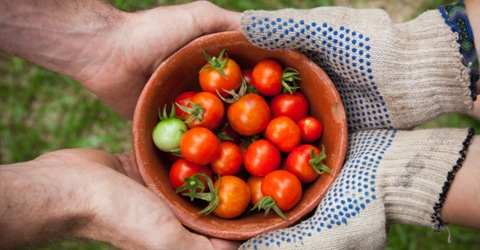

The following is an article from the Community Grants, “Food Is Political” series.
I’d like to think that I have freedom over my food choices At my local grocery store, I can pick and purchase whole plant foods that align with my health and ethical values. I can choose organic produce to avoid added pesticides and buy from brands that seem to be supporting the little guys. I can feel like I’m voting with my dollars and supporting a sustainable food system. You might feel the same freedom of choice yourself.
But this could not be farther from the truth.
This video clip is from a T. Colin Campbell Center for Nutrition Studies online course.
In reality, 10 corporations control almost all of the global food supply[1]. We once lived in local communities where small farmers grew and sold native crops to each other. This type of food system relied on synergy between humans, the soil, and the animals living among us. For example, Native Americans would grow corn, squash, and beans together because these three crops supported each other and replenished the soil[2]. Later, as a result of forced assimilation into the “American way of life”, Native American children were punished for practicing their traditions and this knowledge was lost[3]. Today, a handful of global corporations control what to grow, how to grow it, and how to distribute it to people.
But does it matter if there are only a few corporations that provide us with food? Can we not still rely on them to feed us well?
The more expansive our production, processing, and distribution operations become, the more malignant are the consequences when things go awry. Earth did not evolve to naturally produce massive amounts of any one particular crop in concentrated areas, but that’s what is happening. In the United States, over 90 million acres of land are used to grow grains, 95% of which are corn[4]. Most of our food is grown in similar monocultures. These large-scale productions are more vulnerable to diseases and pests, which can be detrimental to our national food supply[5]. When there is an E. coli outbreak affecting romaine lettuce, all products are pulled from shelves across the US. Chickens, cows, and pigs forced into concentrated animal farming operations (CAFO) produce national outbreaks of Salmonella, E. coli and swine flu (H1N1 virus)[7],[8].
“We need to start taking back ownership over our food. We must become food sovereign.”
Our society increasingly resides in highly concentrated, urban environments that are completely dependent on corporations bringing in food, similar to a human CAFO[9]. Our current food system is unsustainable. Many cities, like Denver, Colorado, would only have enough food for two days if the national food system collapses[9]. While some local economies are more self-sufficient, none are completely independent from the national food system. Not yours, and not mine. While there may be some differences between communities, the vulnerability of the food system has endemic consequences: we are just one global catastrophe away from a food crisis. And we can’t effectively vote with our dollars if there is only one party on the ballot at the grocery store. We need to start taking back ownership of our food. We must become food sovereign.
According to the U.S. Food Sovereignty Alliance, “food sovereignty is the right of peoples to healthy and culturally appropriate food produced through ecologically sound and sustainable methods, and their right to define their own food and agriculture systems.”[10]

How can you free yourself from our current food system and become more sovereign?
The anxiety many of us felt when racing to grocery stores for food when COVID-19 cases spiked in America foreshadows what’s to come if we don’t start decentralizing our food system. Our communities must reclaim our rights to land, seeds, and food. As Michael Brownlee put it, “[the] global food system has itself become the greatest threat to humanity’s being able to feed itself.”[9]
Copyright 2025 Center for Nutrition Studies. All rights reserved.